Birding is a popular hobby among people of all ages. Whether you live in Texas or are traveling to Texas, knowing how to identify the most common backyard birds of Texas is essential to cultivating your bird watching experience.
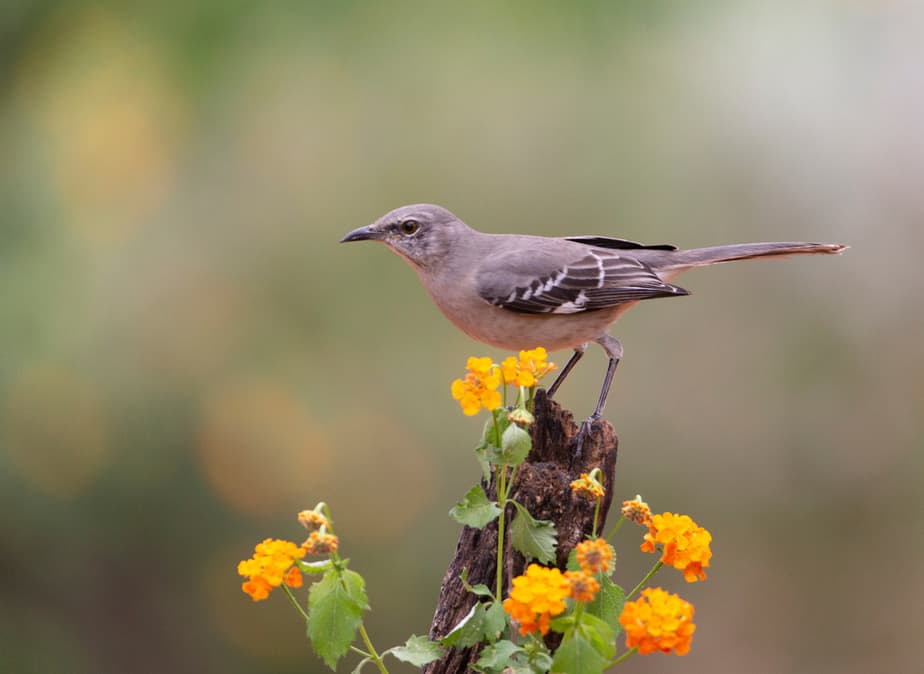
In this article, we’ll be taking a close look at the backyard birds of Texas and providing you with species identification facts, and fun tips for how to make your birdwatching experience a good one!
Table of Contents
1. Northern Mockingbirds: The Texas State Bird
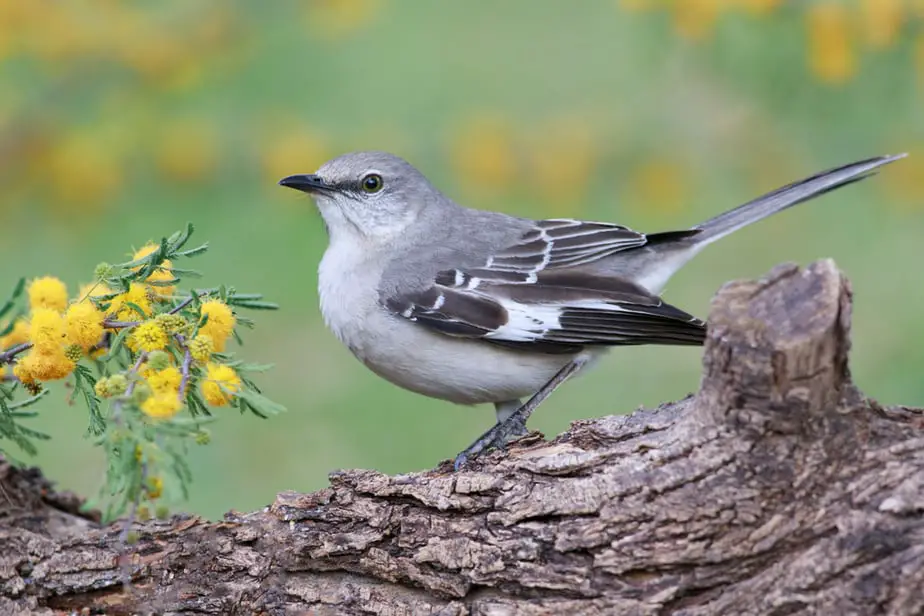
This ornery little Texas bird can be found messing with cats and carrying a tune all day in the backyard trees of Texas.
Mockingbirds are extremely common in Texas and can be spotted just about anywhere throughout the state, hence why they’re the Texas State Bird. These aren’t the shyest of creatures and have been known to pick fights with cats that try to catch them, teasing them by flying down at the cat as it walks or taunting the cat as it climbs up the tree their way.
These birds are not hard to find, as they’ll sit on a fenceline, electrical line, or on a nearby branch so that you can get a good look at them.
Identifying Mocking Birds
Due to their personality, you’ll definitely be able to tell a Mockingbird from a mile away while birding, but just in case you’re having a hard time distinguishing the backyard birds of Texas, here are a few tips for identification:
- Mockingbirds are brown-gray in color overall. Their wings have darker tones of gray and black, with white patches that can be visible when perched or occasionally while in flight. Their underbellies are a slightly lighter gray than their back and head.
- They’re medium-sized birds…about the size of a Robin, with long legs, a small head, and a long, skinny beak.
- A Mockingbird’s tail looks quite long in comparison to its body, and especially long when in flight.
Click the video below to listen to the calls of a Mockingbird:
2. Barn Swallows
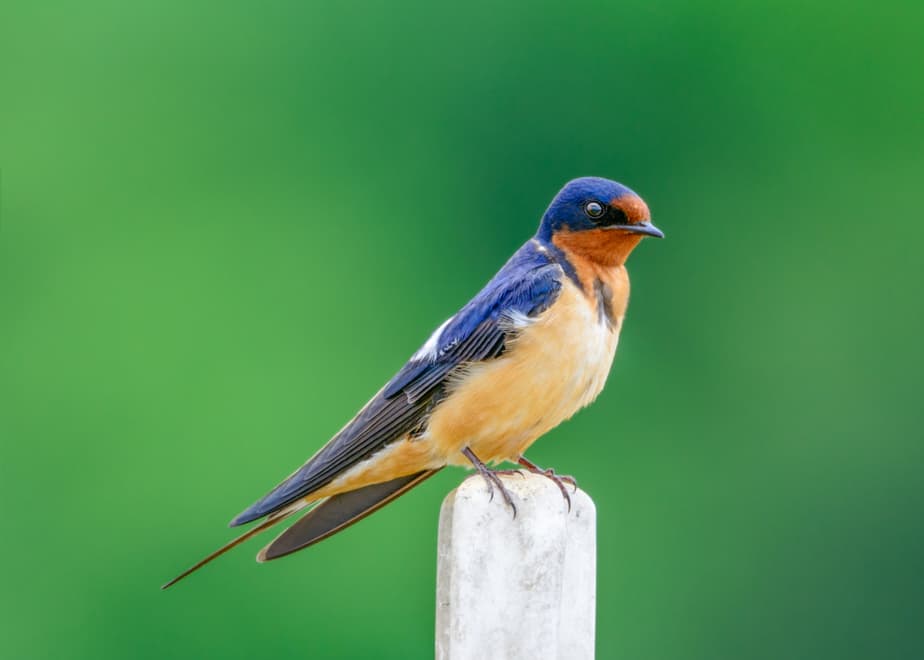
Vibrantly-colored and undoubtedly one of the most beautiful backyard birds of Texas, the Barn Swallow is adorned with deep blue, purple, orange, and yellow hues.
Barn Swallows fly very quickly, in sharp movements, snatching bugs right out of thin air. They usually fly around 100 feet above the ground and are shyer than other Texas birds, making them better to spot in the air rather than in a tree or on a fenceline. You’ll also see them flying in flocks of 2, 3, or more, especially when there are a lot of bugs in a general area.
Their nests are one of the biggest identifying factors of a Barn Swallow and can be found in the eaves of barns, covered decks, and in the corners of house roofs or awnings.
Identifying Barn Swallows
Because of their unique, elongated shape and bright coloring, Barn Swallows are relatively simple to identify. Here’s how:
- Barn Swallows are relatively small in size, about the size of a sparrow, and smaller than a Robin. When they perch, they have a particularly elongated, “coned” shape.
- Their coloring is the most identifiable feature. Males are more brightly colored than females, and consist of deep blue-black coloring on their heads and tails, with a deep blue body, and yellowish-orange undersides and throats.
- A Barn Swallows’ wings are long and pointed, and their tail is short and broad with deep feathering and long forking at the end of the tail.
Click the video below to hear the call of a Barn Swallow:
3. Mourning Doves
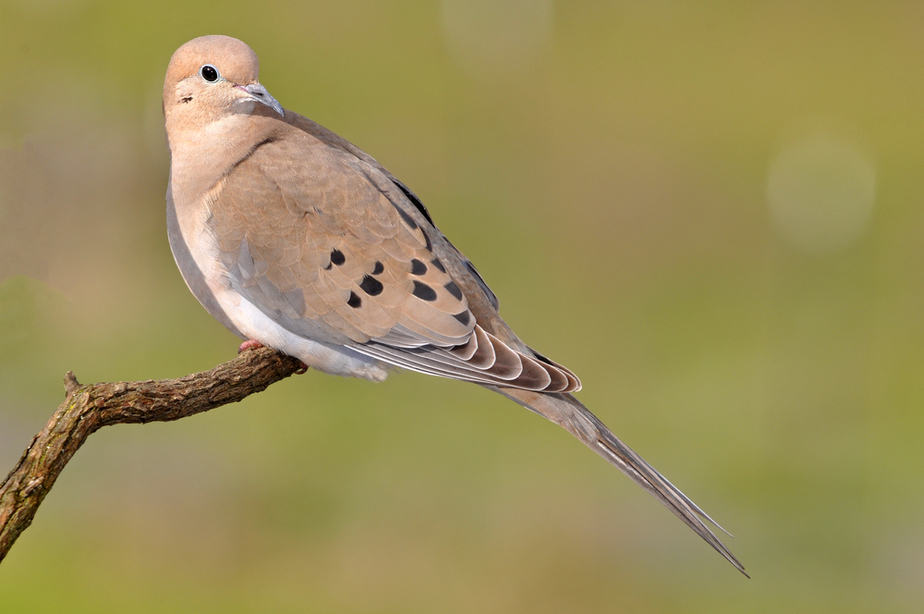
With an appearance that’s both soft and solemn, Mourning Doves are plump and quiet Texas birds. They’re generally seen on the higher branches of trees in the morning and evenings and are recognizable by their soft cooing sounds. When disturbed, a Mourning Dove will rapidly dart away in flight, using intense wing beats to make their escape.
They’re generally seen alone, or in pairs of mates, due to doves mating for life. You can also find them in open field areas or resting on higher places such as telephone lines.
Identifying Mourning Doves
Mourning Doves are a bird that is simply hard to miss due to their unique characteristics. To help you identify a Mourning Dove, consider these recognizable traits:
- Mourning Doves have round, plump bodies with rounded, small heads. They’re a medium-sized bird, around the size of a Robin.
- Their coloring is a brownish-gray with obvious black spots at the base of the wings. Their feathers have white edging down to the tail.
- Mourning Doves have shorter legs and an overall soft, delicate appearance in the face with a short, straight beak and small black eyes.
Click the video below to hear the call of a Mourning Dove:
4. Gold Fronted Woodpeckers
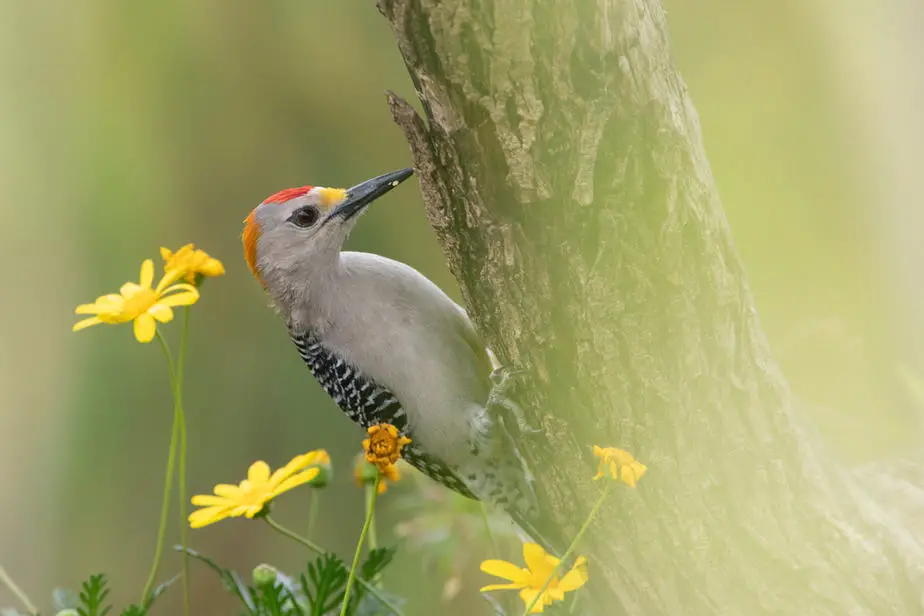
Found all over Texas, from the Pan Handle nearer to Mexico, the Gold Fronted Woodpecker is a common and flamboyant backyard bird of Texas. You’ll see them, usually alone, grasped onto the trunk of a tree, drilling holes into the wood with their powerful beaks.
Identifying Gold Fronted Woodpeckers
Aside from where you’ll usually see a Gold Fronted Woodpecker, there are a few other ways you can identify this bird:
- A Gold Fronted Woodpecker’s coloring consists of bright yellow at the back of the head and base of the beak and orangey reds on the top of the head. Their bellies are a pale grayish tan color, and their backs and wings are a notable barred black and white.
- They’re medium-sized birds, a little larger than the common Robin, and a tad smaller than a Crow.
- They have long, thickish beaks, and black rings around their eyes.
Click the video below to hear the call of a Gold Fronted Woodpecker:
5. Red-Tailed Hawks
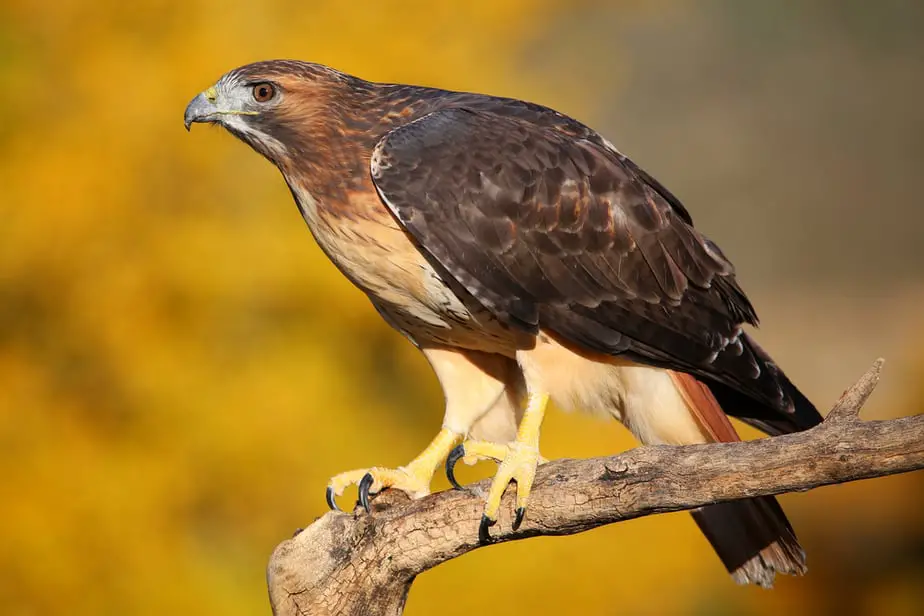
This large, foreboding backyard bird of Texas is a bird of prey, bearing sharp talons and a sharp beak suitable for tearing through flesh. Red-tailed Hawks are the second-largest hawks found in North America and call the plains and fields of Texas home. They’re found in Texas year-round but are more abundant in the winter when hawks from further up North migrate South for the cold season.
You’ll likely see these hawks circling high above a field.
Identifying Red-Tailed Hawks
Because this is one of the largest birds you’ll find in Texas, the Red-tailed Hawk is hard to miss when birding in Texas. Here are some ways to identify them:
- A Red-tailed Hawk’s sheer size is an excellent indicator. These hawks are a tad smaller than a goose, with a wingspan of up to 4 and a half feet.
- Their coloring is a coppery brown-red, with the red most recognizable underneath the tail and wings when they’re in flight. The top of their wings are a rich brown, and their undersides are pale and streaked.
- A Red-tailed Hawk’s eyes are large, round, and generally golden in color.
Click the video below to hear the call of a Red-Tailed Hawk:
6. Blue Jays
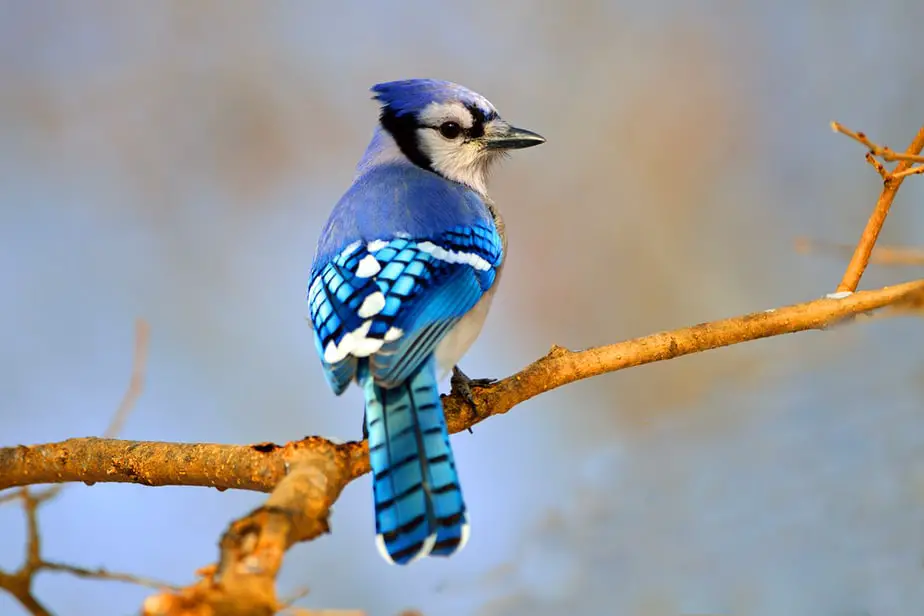
Sporting brilliant blues, the Blue Jay gets its name honestly. You’ll usually find these common birds at the edge of a forest in visible tree branches, in parks, and near trees that bear their favorite nuts, like Oak Trees. They have a variety of calls and will usually sit in trees and “caw”, then fly away without a peep. Their sounds are higher pitched and short, with calls that are rarely drawn out.
Identifying Blue Jays
Due to their flashing blue tones, identifying a Blue Jay among the backyard birds of Texas is a simple feat. Here are some pointers to identifying Blue Jays:
- Not only is their bright blue coloring distinct, but their pattering is, as well. Blue Jays are bright blue in colors, with various blue tones throughout their feathers. Their feathers and tail boast a blue, white, and black pattering with an almost scale-like appearance. Their undersides and faces are a whitish-gray, with black around the eyes and downwards the sides of the head.
- The top of their heads has a tufted of feathers that is cone-shaped. This is bright blue, with the blue coloring leading down the center of their face.
- Blue Jays are medium-sized birds… about the size of a Robin.
Click the video below to hear the call of a Blue Jay:
7. House Sparrow
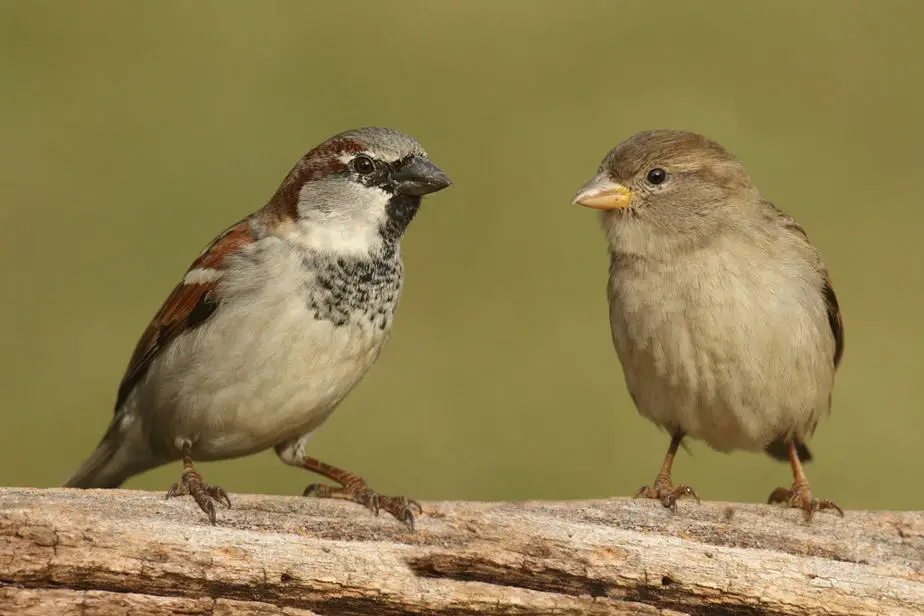
These adorable, tiny Texas birds are smaller than regular backyard birds (like Robins) and not shy in the slightest. You’ll find them just about anywhere in Texas, including hopping on sidewalks, around stores, and in backyards. Where you find one, you’ll generally find many, and you’ll hear them, too — House Sparrows like to make their presence known!
Identifying House Sparrows
Though their tiny builds may make this wild bird hard to spot at first, once you’ve found them, you’ll easily be able to identify the common House Sparrow:
- Both male and female House Sparrows are brown in color. The males, as with most birds, boast more variation in their feathers and will have a black “bib” going down their chin and to their chests. Their underbellies are grayish-white and their wings and backs have a brown pattern to them. Female House Sparrows are dull brown all over.
- A House Sparrow has a frumpy body, with short legs and broad chests. These little birds are round all over, with larger heads, a shorter tail, and stumpy feet.
- Their black or pale yellow beaks are short and thicker in width… all the better to eat bugs and seeds with!
Click the video below to hear the call of a House Sparrow:
8. Tufted Titmouse
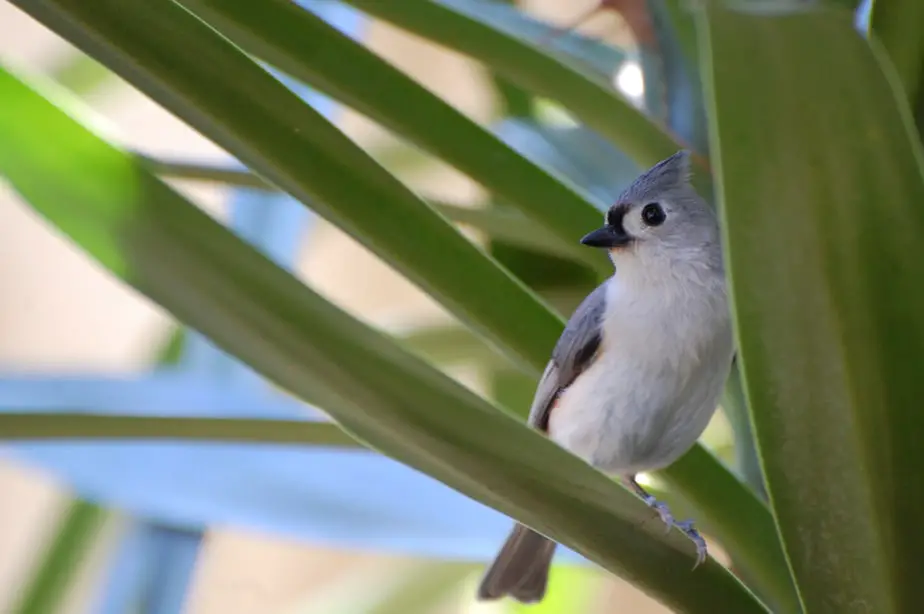
The final backyard bird species on our list, the Tufted Titmouse is a small and adorable bird. Similar in size to a House Sparrow, the Tufted Titmouse is no bigger than 5 or 6 inches from head to tail. You’ll find these little birds at a backyard bird feeder enjoying bird seed next to Woodpeckers and Chickadees or in woodland areas.
Identifying Tufted Titmouse
Small, quick, and dull in color, the Tufted Titmouse may be hard to catch if you’re not next to a feeder that’s frequented often. If you do see a little gray bird, here’s how to identify if it’s a Tufted Titmouse:
- A Tufted Titmouse is dull in color, with gray over its whole body, save for the grayish-white underside and black patch above the beak.
- They have a beautiful whistling call, and will usually be sitting on a branch when they perform.
- Similar to the Blue Jay, a Tufted Titmouse has a cone-shaped puff of feathers sticking straight up from their heads (except the Titmouse’s is gray in color).
Click the video below to hear the call of a Tufted Titmouse:
How to Make Your Birding Experience Better
We see birds daily in our lives, but birding requires patience and some skill to make the experience worthwhile. Here, we’ll be sharing some of our favorite tips for making your birdwatching experience better!
1. Know Where You’re Going
As with all animals, birds have specific environments that they live in and will likely be found hanging around. For example, if you’re searching for a Red-tailed Hawk or a Mourning Dove, you’ll want to go to field areas. For other bird species, a forest’s edge or even a store parking lot will be your best bet.
Knowing where the bird species you’re looking for can be found is essential to making your birding experience go smoothly.
2. Wear Clothes with Natural Tones
When birding, you’ll want to make yourself as unnoticeable as possible. By wearing clothes with earthy tones, like dull greens, browns, tans, and blacks, you’ll blend better into your surroundings, and not give the local birds anything to be on alert about.
3. Avoid Making Sound and Moving Suddenly
Birds are skittish creatures and will fly away at the nearest movement or noise that makes them uncomfortable. When you’re birding, try to stay a reasonable distance away from the bird as to not scare them, but close enough to get a decent look with your binoculars or camera. Sit or stand very still, and only whisper if you need to talk (not talking at all is better, if you can!).
After a moment, you can try moving a little closer to the bird for a clearer shot… but don’t move too quickly! Even if you’re quiet, moving too fast can startle a bird and shoo it away. As you get closer to a bird, walk carefully and slowly, and stop walking if the bird becomes anxious at your presence.
4. Patience is a Virtue — and a Virtue Won’t Hurt You!
If nothing else, be patient. Many bird watchers will spend hours birding to get the right look or right shot of a bird. Birds are active during the day and will hop around from branch to branch, or along the ground. It may take you a minute or so to get a clear look at the bird, especially if you’re in a wooded area with lots of vegetation!
5. Try Using Birdseed
If you really want to get a good look at the local birds, try setting some birdseed on the ground and step away. After a few minutes, flocks of songbirds will come to investigate, giving you a good look at the species. Of course, you won’t get natural photographs this way, but this is a good option if you’re just trying to get a feel of the birds of the area.
Final Thoughts
Texas is a vast terrain filled with gorgeous and unique animals, including their birds! From the tiny Titmouse to the foreboding Red-tailed Hawk, Texas is home to some of the most beautiful birds on earth.
We hope that this guide to the backyard birds of Texas was helpful in your journey to better bird identification! Happy bird watching!